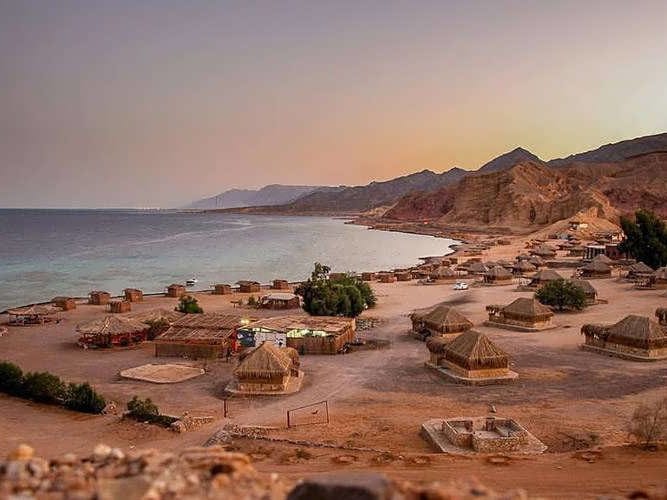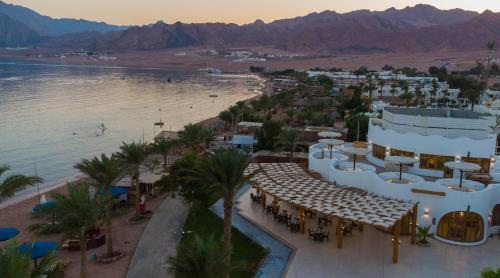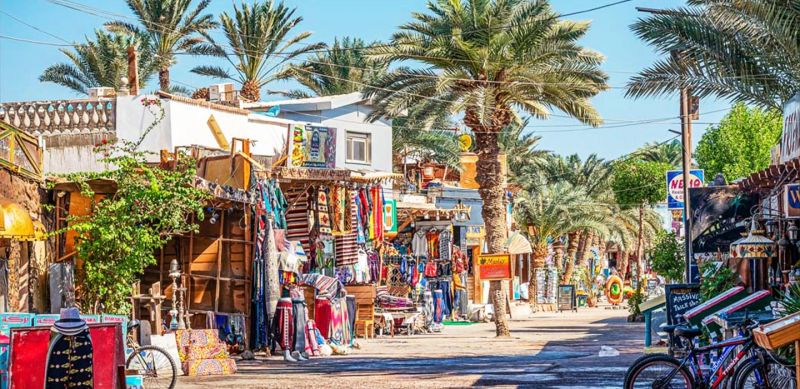
Table of Contents:
- Geographic Overview & Natural Attractions
- Wind & Water Sports
- Adventure & Desert Activities
- Cultural Heritage & Local Life
- Travel Tips & Practical Information
- FAQs
Geographic Overview & Natural Attractions
Once a humble Bedouin fishing village, Dahab lies on Egypt’s South Sinai Peninsula, where golden desert landscapes meet the clear blue waters of the Red Sea. Over time, it has transformed into a popular destination for diving, water sports, and adventure travel.
Nearby, Nabq Bay and Dahab reveal some of Egypt’s lesser-known natural treasures. Visitors here enjoy a unique mix of pristine beaches, protected coral reefs, and enduring Bedouin traditions, offering a more authentic experience compared to Egypt’s mainstream tourist spots.
Location & Geography
Covering 1,130 square kilometers, Dahab is nestled on the eastern edge of the Gulf of Aqaba, where Africa meets Asia. On clear days, visitors can see Saudi Arabia and Jordan across the sea.

Climate Overview
- Summer (May–Sept): Hot and dry, often above 35°C (95°F). Best for diving and snorkeling.
- Winter (Dec–Feb): Mild, 20–25°C (68–77°F). Ideal for hiking and desert tours.
- Spring/Autumn (Mar–May & Sept–Nov): Pleasant 25–30°C (77–86°F). Great for all outdoor activities.
- Marine Ecosystems
- Nabq and Ras Abu Galum—two key protected areas—cover over half of the Gulf of Aqaba’s coastline. These areas host vibrant coral reefs and endangered marine species, such as whale sharks, hammerheads, and green turtles.

Desert & Mountain Terrain
Wadi Rasasah and surrounding landscapes offer a dramatic contrast: rugged mountains, pristine beaches, rare mangroves, and over 130 rare plant species.
Adventure Sports & Activities
Dahab is a hotspot for adventure tourism, attracting thrill-seekers from around the world.
Top Diving Sites
- Blue Hole: Famous for deep wall dives.
- Lighthouse Reef: Excellent for night dives (0.5–40m depth).
- The Canyon: Features underwater caves (16–54m depth).
- Eel Garden: Known for its garden eels (16–18m depth).
Wind & Water Sports
Consistent winds make the Lagoona a prime spot for:
- Windsurfing & kitesurfing
- Parasailing & wakeboarding
- Snorkeling tours
Modern equipment and expert instructors welcome beginners and pros alike.
Desert Adventures
- 4×4 Safaris: Explore valleys and scenic mountain passes.
- Camel Treks & Quad Biking: Reach remote spots like Abu Galum.
- Hiking: Offers panoramic views of the Red Sea.
End your day at a traditional Bedouin camp, enjoying local food and music under the stars.

Cultural Heritage & Local Life
Dahab’s identity is deeply tied to the Muzziena tribe, who settled here from the Arabian Peninsula 800 years ago. They’ve shaped the town’s culture by blending Bedouin tradition with modern tourism.
Local Communities
Muzziena men work in guiding and hospitality, while women—respected as community “queens”—run family businesses and craft unique handmade goods. Bedouin law, enforced by tribal Sheikhs, continues to govern community life.

Markets & Crafts
The beachside Promenade is Dahab’s vibrant social center, featuring:
- Bedouin jewelry, textiles, and pottery
- Fresh produce and spices
- Local street food
- Weekly markets with live music and artisan stalls
Dining Experience
Don’t miss:
- Om Ali: Warm bread pudding with vanilla ice cream
- Koshary: Egyptian comfort food with rice, lentils, and pasta
- Bedouin Tea: Often served with a dose of local hospitality
Dining options range from rustic mountain eateries to elegant beachfront cafes. For a cultural dining experience, try HKAYT Restaurant—known for its live music and mountain views.
Practical Travel Information
When to Visit
- High Season (Sept–Nov): Best weather and full activity access; higher prices.
- Low Season (Dec–Feb): Fewer tourists and cheaper rates; cooler, but still enjoyable.
- Shoulder Season (Mar–May): Great balance of weather, price, and availability.
Conclusion
Dahab and Nabq Bay offer a refreshing mix of nature, culture, and adventure. From diving the legendary Blue Hole to exploring desert trails and connecting with Bedouin traditions, these destinations stand apart from Egypt’s more commercial resorts.
Accessible via Sharm el-Sheikh, these spots are ideal for both adrenaline junkies and relaxed travelers. Whether you’re into world-class diving or cultural immersion, the region promises a memorable and enriching experience.

FAQs
1. How long should I stay in Dahab?
A minimum of 3 days is recommended to experience the highlights. Longer stays allow more in-depth exploration.
2. Is Dahab worth adding to my Egypt itinerary?
Yes! It offers a unique blend of adventure, nature, and authenticity often missing in Egypt’s busier tourist areas.
3. How does Dahab compare to Sharm el-Sheikh?
Dahab is more relaxed and budget-friendly, while Sharm el-Sheikh offers luxury and a more international feel.
4. When is the best time to visit?
The ideal period is from November to February for mild temperatures and comfortable outdoor conditions.
